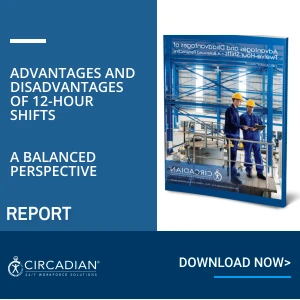The 12-hour shift schedule has become a common choice for many industries requiring round-the-clock operations. With so many variations available, from the DuPont to the 2-3-2, it can be challenging to find the right fit for your workforce and business needs. Understanding the advantages and disadvantages of different 12-hour shift schedules can help ensure a balanced approach to operational efficiency and employee well-being.
While the 12-hour shift offers flexibility and more extended periods off, no schedule is without trade-offs. Each one impacts workers' physical health, social life, and work-life balance differently. Here are some common 12-hour schedules to consider, along with their pros and cons.
Background:
The DuPont schedule originated at the DuPont Company in the 1950s and has been widely adopted in industries such as chemicals and manufacturing.
This schedule features a 28-day cycle with shifts alternating between four consecutive days on, three days off, three nights on, and one day off. It includes a long seven-day break in each cycle, which is a key selling point for many workers.
Benefits:
Extended time off: Employees get seven to eight consecutive days off in a 28-day rotation, creating the feeling of a mini-vacation.
Less frequent transitions: Fewer shift changes allow workers to settle into a routine, reducing the disruption caused by constant changes.
Drawbacks:
Fatigue risk: Working four consecutive night shifts can be exhausting, especially for employees who struggle with overnight schedules.
Recovery time: In some variations, the break between day and night shifts is only 24 hours, which may not provide enough recovery time for employees.
Background:
The 2-3-2 schedule pattern many names, including the "Every Other Weekend Off" (EOWEO) schedule, the Pitman Schedule, and the Panama Schedule to name a few. As its core, the 2-3-2 follows a pattern of two days on, two days off, three days on, two days off, and three days off.
This schedule can be worked as a fixed schedule, a rotating schedule and a hybrid (2-crew rotate; 2-crews are fixed)
Benefits:
Three-day weekends: Workers are guaranteed a three-day weekend every other week, which helps with work-life balance. Balanced workweeks: Employees never work more than three consecutive shifts, making it easier to manage rest.
Drawbacks:
Short recovery times: With only two consecutive days off, workers may struggle to get enough rest between shifts.
Rapid day-night transitions: Switching between day and night shifts every few days can be tough on circadian rhythms, leading to fatigue and sleep disruptions.
Background:
In this popular schedule, employees work for four consecutive days or nights, followed by four days off. Variations exist regarding how frequently workers switch between day and night shifts, but it remains a popular choice in industries where continuous operations are necessary.
Benefits:
Ample recovery time: With four days off in a row, workers have enough time to rest and recuperate.
Weekend flexibility: Every eight-week cycle gives workers three consecutive weekends off, boosting employee satisfaction.
Drawbacks:
Shifting days off: Since the schedule follows an eight-day pattern, employees' days off move forward each week, making it hard to plan for regular social or family activities.
Night shift fatigue: Four consecutive night shifts can be physically demanding, especially for older workers or those in physically strenuous roles.
Background:
A 12-hour swing shift schedule involves workers rotating between day and night shifts, often on a weekly or biweekly basis. Swing shifts are commonly used in industries requiring continuous operations, such as healthcare, manufacturing, and security.
Benefits:
Equal day-night distribution: Employees experience a balance of day and night shifts, reducing the overexposure to night work that can lead to health issues.
Improved flexibility: Swing shift schedules provide flexibility in managing both operational needs and employee preferences, making it easier to cover peak work times.
Drawbacks:
Circadian rhythm disruption: Constant switching between day and night shifts can lead to chronic sleep disturbances, fatigue, and reduced alertness.
Social impact: Regularly switching between shifts can be socially disruptive, as employees may find it difficult to maintain a consistent schedule for family and social activities.
Ultimately, there are over 300 variations of 12-hour shift schedules, each with unique benefits and challenges. The right schedule for your organization depends on balancing operational efficiency with the well-being and satisfaction of your workforce. Consider the physical toll of switching between day and night shifts, the need for recovery time, and the impact on employees' social lives when evaluating schedules.
Want More Information on 12-Hour Shift Scheduling?
Interested in Shiftwork, Scheduling & Fatigue Risk Management Best Practices?
Subscribe to CIRCADIAN's email list for cutting-edge information, updated research findings, and easy-to-implement strategies, all tailored to optimize the health, safety, and performance of your shiftwork and extended hours operations.
Join our community of 32,000+ industry leaders and receive practical tips and expert insights to optimize your 24/7 workforce.











